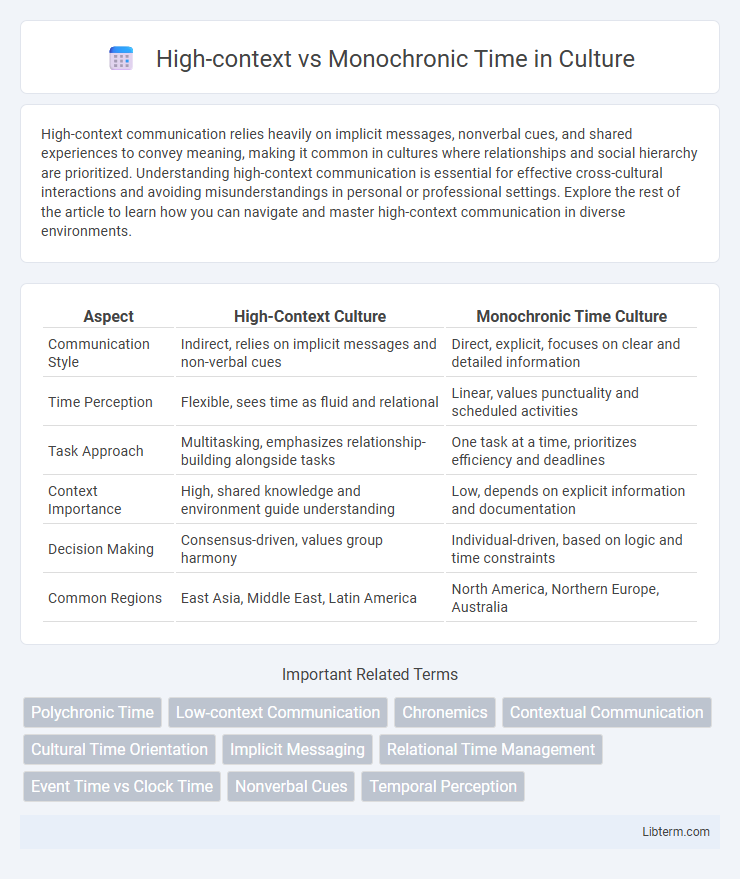High-context communication relies heavily on implicit messages, nonverbal cues, and shared experiences to convey meaning, making it common in cultures where relationships and social hierarchy are prioritized. Understanding high-context communication is essential for effective cross-cultural interactions and avoiding misunderstandings in personal or professional settings. Explore the rest of the article to learn how you can navigate and master high-context communication in diverse environments.
Table of Comparison
| Aspect | High-Context Culture | Monochronic Time Culture |
|---|---|---|
| Communication Style | Indirect, relies on implicit messages and non-verbal cues | Direct, explicit, focuses on clear and detailed information |
| Time Perception | Flexible, sees time as fluid and relational | Linear, values punctuality and scheduled activities |
| Task Approach | Multitasking, emphasizes relationship-building alongside tasks | One task at a time, prioritizes efficiency and deadlines |
| Context Importance | High, shared knowledge and environment guide understanding | Low, depends on explicit information and documentation |
| Decision Making | Consensus-driven, values group harmony | Individual-driven, based on logic and time constraints |
| Common Regions | East Asia, Middle East, Latin America | North America, Northern Europe, Australia |
Understanding High-Context Cultures
High-context cultures rely heavily on nonverbal cues, shared experiences, and implicit communication to convey meaning, making relationships and social harmony crucial in interactions. Understanding high-context cultures requires sensitivity to context, body language, and unspoken rules, which often override explicit verbal messages. This approach contrasts with monochronic time orientation, which prioritizes schedules, punctuality, and direct communication in task-driven environments.
Key Features of Monochronic Time
Monochronic time emphasizes scheduling, punctuality, and task completion, with individuals focusing on one activity at a time. It values linear progression, deadlines, and strict adherence to plans, often found in Western cultures like the United States and Germany. This time orientation contrasts with high-context cultures by prioritizing efficiency and clear, structured communication over relational nuances.
Communication Styles in High-Context Societies
High-context societies rely heavily on non-verbal cues, implicit messages, and shared experiences to communicate effectively, often valuing harmony and relationship building over explicit verbal exchange. In these cultures, messages are often indirect, with meaning derived from context, tone, and body language, requiring keen observation and intuition to interpret. Communication tends to be more holistic and relational, where maintaining group cohesion and saving face are paramount.
Time Management: Monochronic vs. Polychronic Approaches
Monochronic time management emphasizes strict scheduling, punctuality, and completing one task at a time, making it ideal for environments that value efficiency and deadlines. Polychronic time management allows multitasking, flexible deadlines, and prioritizes relationships over rigid schedules, often thriving in high-context cultures where communication and social interaction are integral. Understanding these approaches is crucial for global teams to optimize productivity and minimize cultural misunderstandings in time-sensitive projects.
Relationship Building in High-Context Environments
High-context cultures prioritize relationship building by emphasizing trust, nonverbal cues, and shared experiences, which are crucial for effective communication and collaboration. In these environments, time is seen as fluid, allowing conversations and interactions to develop naturally without strict adherence to schedules. This flexible approach fosters deeper connections and mutual understanding, essential for long-term partnerships and successful negotiations.
Workplace Dynamics and Time Perception
High-context cultures emphasize relationships and non-verbal cues, leading to flexible time management in workplace dynamics where deadlines are viewed as guidelines. Monochronic time cultures prioritize schedules, punctuality, and linear task completion, creating a work environment focused on efficiency and strict adherence to deadlines. Understanding these differences in time perception enhances cross-cultural collaboration and minimizes conflicts in global teams.
Decision Making Across Cultural Contexts
High-context cultures rely heavily on implicit communication and relational cues in decision making, emphasizing group harmony and consensus over speed. Monochronic time cultures prioritize structured schedules, punctuality, and sequential task completion, favoring prompt, individual decisions based on objective data. Understanding these differences is crucial for effective cross-cultural collaboration, as mismatched expectations can lead to misunderstandings and delays in business environments.
Common Misunderstandings in Cross-Cultural Settings
High-context cultures rely heavily on nonverbal cues and shared experiences, often leading to misunderstandings when interacting with monochronic time cultures that prioritize schedules and punctuality. Common misinterpretations arise when monochronic individuals perceive high-context communication as vague or inefficient, while high-context individuals view strict adherence to time as rigid or impersonal. Effective cross-cultural collaboration requires recognizing these differences to prevent conflicts stemming from contrasting perceptions of time and communication styles.
Strategies for Bridging Time Orientation Gaps
Bridging high-context and monochronic time orientation gaps requires clear communication strategies such as setting explicit deadlines and prioritizing relationship-building to align expectations. Utilizing visual scheduling tools and mutually agreed-upon timelines enhances coordination across cultures that value flexibility versus strict punctuality. Encouraging feedback loops and adapting to both task-focused and relational approaches supports effective collaboration in diverse time perception environments.
Practical Tips for Navigating High-Context and Monochronic Cultures
In high-context cultures, prioritize building relationships and understanding implicit cues to effectively communicate and avoid misunderstandings. In monochronic cultures, emphasize punctuality, clear schedules, and direct communication to respect time boundaries and increase efficiency. Adapting your approach by observing cultural norms and asking clarifying questions fosters smoother interactions and mutual respect across both settings.
High-context Infographic

 libterm.com
libterm.com